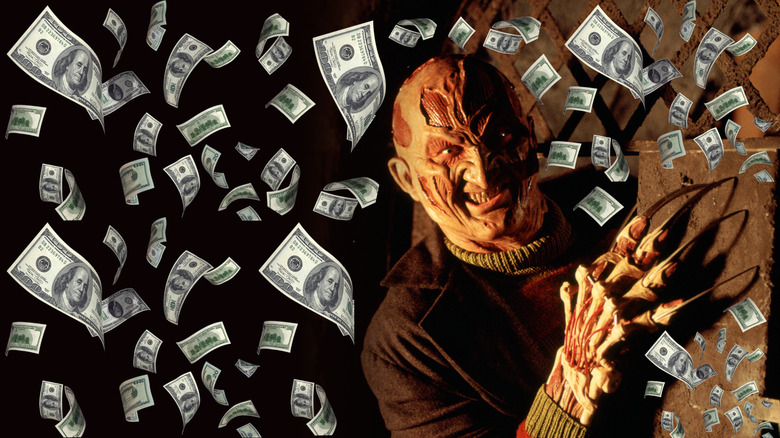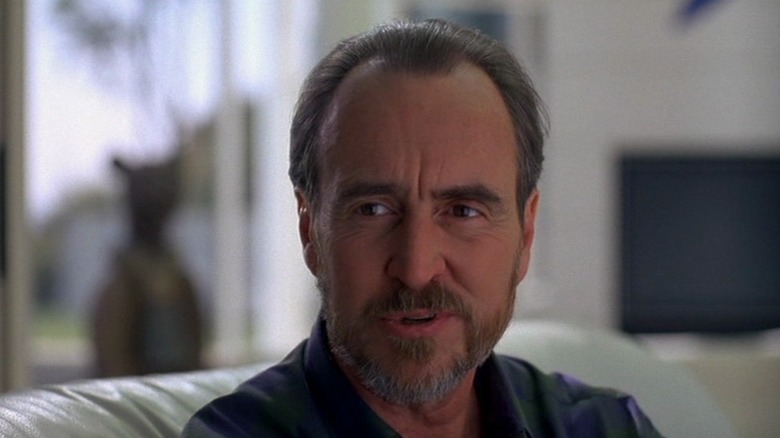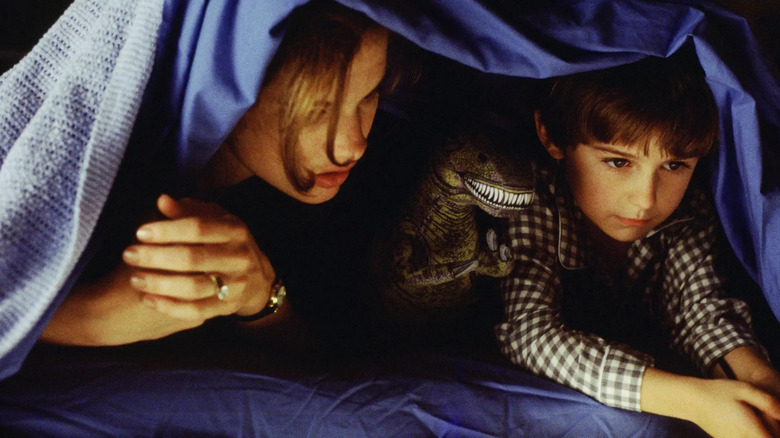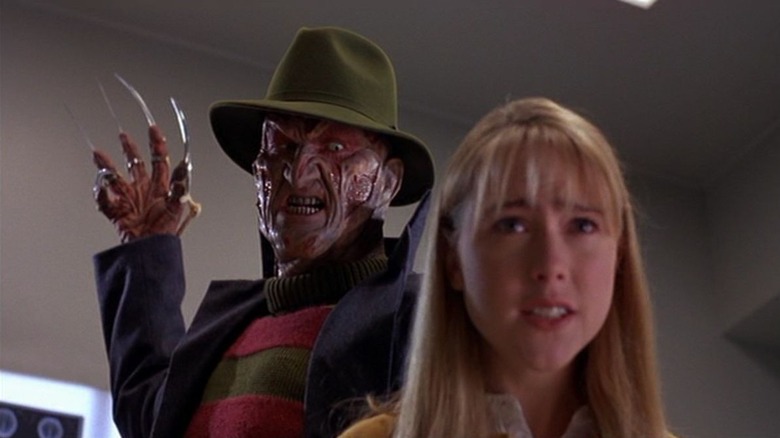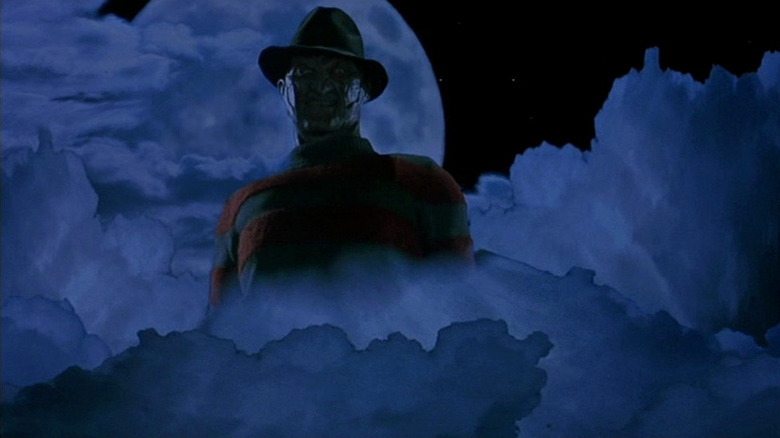30 Years Ago, Wes Craven's Most Inventive Slasher Was Ignored At The Box Office
(Welcome to Tales from the Box Office, our column that examines box office miracles, disasters, and everything in between, as well as what we can learn from them.)
"Who better to resurrect Freddy than his creator?" This is the question posed by producer Bob Shaye, playing himself, in 1994's "New Nightmare," typically billed as Wes Craven's "New Nightmare." That's because Craven, who had long since stepped away from directing the Freddy Krueger films, had returned to his post behind the camera. However, this wasn't just for a paycheck; Craven was about to provide the genre with its boldest reinvention arguably since he introduced us to Freddy in the original nightmare-inducing "A Nightmare on Elm Street" a decade earlier.
The film sees Craven, as well as actors Heather Langenkamp (who played Nancy in the original "Nightmare") and Robert Englund (who had been Freddy in every entry in the franchise up to that point) portraying fictionalized versions of themselves. While Heather is considering making another film with Craven, her son Dylan (Miko Hughes) falls under the spell of Freddy Krueger (Robert Englund), who has found a vessel into the real world. Even though it's now considered one of the best "Elm Street" movies, the world wasn't ready to embrace Craven's out-of-the-box idea at the time. What it did do, however, is tee up the ball for one of the biggest reinventions of the slasher ever.
In this week's Tales from the Box Office, we're looking back at "New Nightmare" in honor of its 30th anniversary. We'll go over how the film came to be, what motivated Craven to come back to the franchise, what happened when it hit theaters, what happened in the years that followed, and what lessons we can learn from it three decades later. Let's dig in, shall we?
The movie: Wes Craven's New Nightmare
"The problem with making sequels [...] is that if you continue with the villain as the center of the story, which is certainly the 'Nightmare' paradigm, then you simply have to introduce a new set of victims every time," Craven said in a featurette on the "New Nightmare" Blu-ray release. "After a while, it becomes quite repetitive. You have no real story continuity except the villain."
That was the very problem that Craven had to contend with while making this film. For context, Craven's "A Nightmare on Elm Street" was such a huge success in its day that it saved New Line Cinema. The studio has even become known in some circles as "The House That Freddy Built" because of this. But the filmmaker didn't return for "Nightmare 2" or any of the other sequels as a director, though he did come back as an executive producer on the third installment "Dream Warriors." Perhaps not surprisingly, it's widely-considered one of the best sequels.
In any event, after the critical failure of 1991's "Freddy's Dead: The Final Nightmare," New Line knew it needed to reinvent the franchise if it wanted to keep things going. Again, what better way to do that than by circling back to the creator? Beyond the money, Craven's reason for signing on had to do with the nature of the "Elm Street" sequels up to that point:
"There were business reasons why it was interesting to me. For instance, the pay was very good, and I was able to negotiate points in the sequels that I had not been given before. There were a lot of reasons why I should do it, but I said, 'I can't do it unless I, again, feel like I'm bringing it up to another level.' I went back and looked at all of the sequels. After a while, I had a hard time following any sort of storyline, or find any consistency to build on for a new one. That was, ironically, the kind of propulsion for jumping onto the film entirely."
'Every kid knows who Freddy is. He's like Santa Claus'
Frankly, New Line was sort of in a box here. It completely ended things with "Freddy's Dead." Not that such things have ever stopped horror franchises before, but the studio still needed to find a creative way to bring Robert Englund's sweater-wearing slasher back once again. That's where Craven's meta concept probably seemed appealing, even if it also likely would have been dubbed too risky at another point in time.
For what it's worth, Craven fully committed to the bit. "Freddy Krueger" is even credited as "Himself" in the end credits.The studio gave him an $8 million budget to work with, which was more or less in line with several of the sequels when accounting for inflation. Unfortunately, not everything Craven came up with could make it to screen. Englund, speaking in 2022, revealed a pretty impressive scene for "New Nightmare" that Craven simply didn't have enough money to shoot:
"I'm having a nightmare. I'm in bed with my wife up in the Hollywood Hills in my Spanish mansion — which I don't own, but that was Wes's imagination — and I'm tossing and turning and we go into my nightmare. And my nightmare was about whether I was trapped in the role of Freddy. In the scene, Robert Englund is in a spider's web being cocooned by a giant black widow. And on the underbelly of the black widow are red and green stripes, the same color stripes as Freddy's sweater."
New Line executive Sara Risher, speaking in the comprehensive documentary "Never Sleep Again," laid out why the production was a relatively smooth one: "All of the other directors had to be guided through, but Wes, by then, was the master." Indeed, by that time, Craven had enough experience under his belt to be considered a master of the genre, whereas other filmmakers who had shepherded the "Nightmare" sequels over the years were more untested. And, with all due respect, none of the other directors in this franchise would wind up on the Mount Rushmore of horror filmmakers. Craven likely would.
The financial journey
While Craven delivered the goods, with "New Nightmare" receiving some of the best reviews the franchise had earned in years, it was still a tough concept to market to the masses. It wasn't as simple as "Freddy kills more people in increasingly wild ways." New Line had to try and explain that meta premise to prospective moviegoers. The trailer (seen above) demonstrates how hard it was to cohesively boil down the notion for horror fans who had never encountered such a thing on this scale.
Released on the weekend of October 14, 1994, in that sweet, pre-Halloween window, "New Nightmare" opened in third place with $6.6 million, losing out to Quentin Tarantino's surprise hit "Pulp Fiction" ($9.3 million) and "The Specialist" ($8.9 million), which was in its second weekend. For comparison's sake, "Freddy's Dead" had opened to $12.9 million three years earlier, en route to a $34.8 million domestic finish. In short, it wasn't exactly the revival that Craven or the studio had hoped for, at least not in the early going.
Things got worse in the coming weeks as the film quickly tumbled out of the top five. By the first weekend of November, thanks to the likes of "Stargate" and Kenneth Branagh's "Frankenstein," it was completely out of the top 10. "New Nightmare" finished its run with just $18 million domestically to go with a mere $1.6 million in reported overseas grosses for a grand total of $19.7 million.
In all likelihood, the film made more money overseas in other ways. (International box office wasn't as much of a thing for American studios in those days for certain films.) Be that as it may, the film still ended up becoming the lowest-grossing "Elm Street" movie to date, trailing "A Nightmare on Elm Street: The Dream Child" ($22.1 million). That was that ... until it wasn't.
New Nightmare indirectly revived the cinematic slasher
Craven's commercial woes continued when his next film, the 1995 horror-comedy "Vampire in Brooklyn," came out and was lambasted by critics on its way to flopping at the box office. Mercifully, by then Craven had already attached himself to a movie written by a then-up-and-coming screenwriter by the name of Kevin Williamson going under the name "Scary Movie." The title would eventually be changed to "Scream," which hit theaters in 1996 and became a massive hit, pulling in $173 million worldwide while reviving the slasher genre in a huge way.
Because it was seen by so many more people, the meta commentary on the horror genre displayed more playfully in "Scream" got an awful lot more credit for being clever and fresh. But those ideas were first explored in "New Nightmare." Indeed, it's hard to imagine a world in which "Scream" exists the way it does without Craven's final word on Freddy Krueger.
The other important thing is that, particularly in the '90s when home media was a much larger deal, films didn't just live and die by the box office. As a result, in no small part thanks to the success of "Scream," Craven's "New Nightmare" founds its audience in the years that followed. As Englund explained in a 2020 interview:
"When 'New Nightmare' came out, it was successful, but it wasn't a huge hit. It was just a moderate success. And then Wes Craven's 'Scream' came out and that was even more meta and more deconstructed, but it was a little easier for the audience to digest, and all the characters were people that were self-referencing horror movies and the elements in horror movies. Wes was playing with that in 'New Nightmare' [...] Eventually, a lot of the 'Scream' fans started renting 'New Nightmare' and they picked up on just how smart it was."
The lessons contained within
What Craven did in 1994 extends beyond teeing up the wildly successful "Scream" franchise, which cemented him as one of the true greats in horror history. "New Nightmare" was also arguably the initial template for the so-called legacy sequel, which is where movies like "Star Wars: The Force Awakens" or "Jurassic World" come from. These are movies that are actively having conversations with their past, leading to huge returns commercially as they're able to tap into the nostalgia factor for multiple generations. That isn't exactly what Craven was trying to accomplish here, but it's easy to see how that meta concept gets manipulated over the years to bring us to such a place.
It says an awful lot that Englund has name-checked "New Nightmare" as his favorite sequel of the bunch. While the actor always brought his A-game as Freddy, it's hard to argue against things having gotten stale by the time the later entries rolled around. Meanwhile, the quest for more money ensured that the franchise was going to continue. Craven understood that and made the best of the situation.
"We already killed Freddy Krueger," Craven said in response to New Line founder Robert Shaye's proposal that he make a seventh "Nightmare" movie. "But he said there was an audience for one more. He asked if I could come up with an idea for Freddy to come back." Therein lies the key lesson for Hollywood in the modern era.
The fact of the matter is, money is always going to be the primary driver. It's why we're getting "Scream 7" in a couple of years. It's also why we're getting a "Halloween" TV show. It's just the way things are. Within that, Craven still found a way to answer the question of "Why?" When following the money, it can't just be "Because this thing is popular." Creatively, when there's a good reason for the movie to exist, it always works out better. That's precisely why 2010's "A Nightmare on Elm Street" remake didn't pan out.
In this case, a modest success became a horror classic — one that paved the way for yet another massive franchise. Had Craven made a paint-by-the-numbers, paycheck-driven sequel? Who knows.
